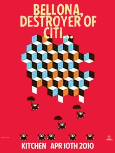When I posted on my livejournal that there was a play version of Dhalgren, one of my friends thought it was an April Fool. Dhalgren‘s more than 800 pages long, a cult classic, it really doesn’t seem like something that could be adapted for a stage version. Since it had been, I felt I had to go—indeed, since it was there and I could, that it would be irresponsible not to. So I went to New York on the train, and last Saturday evening ten of us went to an avant garde theatre called The Kitchen to see Bellona, Destroyer of Cities, adapted and directed by Jay Scheib.
The first thing is that it was Dhalgren. It felt like Dhalgren. What it felt like was quite familiar to me—it was just like when you go to see a Shakespeare play where they’ve cut some scenes, set it in a different period, switched the gender of some characters and conflated others. You want to argue with their choices, but that argument doesn’t stop it being a legitimate version of the play. And that’s just how this was. There were things I liked and things I didn’t like, things that worked, odd choices, things that got left out or underplayed that I’d have kept, but it was inarguably Dhalgren, and that’s really quite an achievement.
The set was the skeleton of buildings, with some walls present, so you could partly see in. Things happening that you couldn’t see could sometimes be seen on a big screen, so your attention was constantly divided. I often don’t like this kind of technique, but it worked really well for this material. A couple of other effective theatrical things were a character in a spacesuit being carried by two other characters as if weightless and floating, and Eddy flinging himself around and slamming himself to the floor. Most of the sex happens in flashes in the back room and is incomprehensible and multiplex, just like in the book. I loved the way we kept seeing the original Dhalgren cover, first on the floor behind a sex scene on the screen, and then as the cover of the poetry book.
When you reverse genders, you learn an awful lot about gender expectations. Charm, which the Kid has, is an expected quality in women, less so in men. So making her a woman made her much more conventional. The same goes for sexual receptivity—the Kid doesn’t initiate but falls into what sex comes along. I think she’s a less interesting character as female. You also lose a lot of the queer stuff, especially as they chose to leave out the threesome and the whole dynamic of that. The thing I didn’t immediately notice is that the same goes for violence. In the book, Kid is beaten up, but later is violent himself, in the Scorpion runs, and mugging a guy. Here we see the beating, but not any of the performative violence. This changes the balance. I know why they did it. There’s a way in which the plot of Dhalgren wraps—not just the Joycean beginning with “to wound the autumnal city” and ending with “I have come” but the parallel scenes and dialogue with the people leaving/arriving as Kidd arrives/leaves. Those people are women when Kid is a man, and so it must have seemed like a great idea to have a female Kid and another iteration. But Delany had already been reversing expectations. Taking a largely passive gentle poet and making him female plays into stereotypes and expectations not against them, and they could have done with more awareness of that.
Most of the play is very close to the book, but with very different pacing. Much of the dialogue is straight off the page. Characters are conflated, huge chunks are left out, but I could always see why they’d done it—and with all that, it’s really surprisingly true to the original. Dhalgren‘s a book with a lot in it, and because of its moebius spiral structure it’s hard to say what’s essential. I have no idea how comprehensible the play would have been without the novel breathing down its shoulder. But they gave us the ruined city, the spiral, the whole thing with the poetry, the elevator shaft, George and June, and the vexed question of shots and the riot.
What we didn’t have was science fiction. All the things that make Dhalgren take place in the vague future—the holograms, the orchids, the chain with prisms and mirrors and lenses—were left out. Instead of science fiction’s promise of answers just out of sight, the play gave us magic realism, or maybe magic surrealism. I’d been wondering how they were going to do the holograms, which are very important to the novel, and had thought of several ways that would work. I was sorry but not distressed—what bothered me was replacing the orchid with a gun. Mind you, it bothers me when they replace swords with guns in Shakespeare plays, and for the same reason—it’s a different distance of violence. Delany deliberately gives the Scorpions claws, not guns, there’s a scene in the book where they explicitly repudiate a gun. It’s strange that they got some of the hardest stuff so right and then did this. Oh well.
The actors were all very good and the doubling was clear and effective. The run is over, or I’d recommend it. Perhaps it will be revived. It was Dhalgren, and I’m very glad I saw it.
Jo Walton is a science fiction and fantasy writer. She’s published eight novels, most recently Half a Crown and Lifelode, and two poetry collections. She reads a lot, and blogs about it here regularly. She comes from Wales but lives in Montreal where the food and books are more varied.










